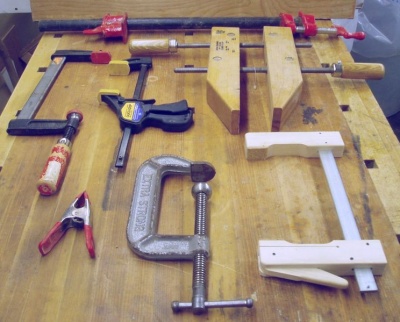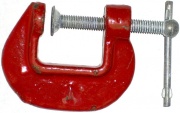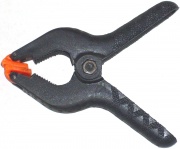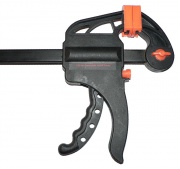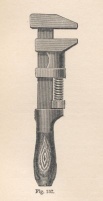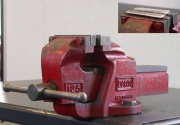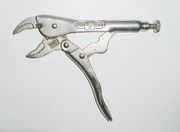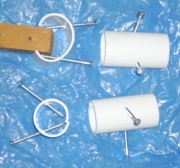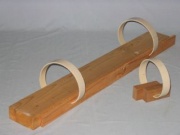Difference between revisions of "Clamp"
(m) |
|||
| (34 intermediate revisions by 4 users not shown) | |||
| Line 5: | Line 5: | ||
===G clamp=== | ===G clamp=== | ||
| − | + | [[image:G_clamp_19-6.jpg|right|180px]] | |
| − | G clamps are prone to denting the workpiece, due to high force on a small pad, or scratching workpieces. Loose load spreading pieces of wood, plastic, etc are used to avoid this, but make handling the assembly less easy. | + | Also known as a C clamp or G cramp, this is a traditional clamp with high clamp force and numerous uses. The long [[Screws|screw]] thread tends to make it slow in use, so quick release clamps are preferred where their lower clamp force is sufficient. |
| + | |||
| + | G clamps are prone to denting the workpiece, due to high force on a small pad, or scratching workpieces. Loose load spreading pieces of wood, [[plastic]], etc are used to avoid this, but make handling the assembly less easy. | ||
===Spring clamp=== | ===Spring clamp=== | ||
| − | + | [[image:Spring clamp 0017-5.jpg|right|180px]] | |
| − | + | * Very low clamping force compared to traditional clamps. | |
| + | * Very quick. | ||
| + | * Useful for holding things in place while [[fixing]] them | ||
| + | * often several clamps are needed to give enough holding force. | ||
| − | ===Sash=== | + | Also see PVC pipe clamp below. |
| + | |||
| + | ===Sash Cramp=== | ||
| + | A sash cramp or sash clamp is a long bar clamp for larger pieces of woodwork. Widely used for [[Wood glues|gluing]] wooden goods. | ||
===Quick release clamp=== | ===Quick release clamp=== | ||
| − | These have a trigger mechanism to tighten the clamp, and a button to release grip. These find a lot of use in DIY due to fast easy use. The clamping forces don't compare to screw operated clamps, so they're not suitable for all tasks. Use of several quick release clamps improves total clamp force. | + | [[image:Klieste_truhlarske.jpg|right|180px]] |
| + | |||
| + | These have a trigger mechanism to tighten the clamp, and a button to release grip. These find a lot of use in [[Special:Allpages|DIY]] due to fast easy use. The clamping forces don't compare to [[Screws|screw]] operated clamps, so they're not suitable for all tasks. Use of several quick release clamps improves total clamp force. | ||
===Spreader=== | ===Spreader=== | ||
| + | Spreaders push things apart instead of squeezing them together. Many quick release clamps can have their jaws reversed to do this. Special purpose spreaders are also available. | ||
===Monkey wrench=== | ===Monkey wrench=== | ||
| + | [[Image:Monckywrench.jpg|right|103px]] | ||
| + | |||
| + | The [[monkey]] wrench is often referred to but not much used today, though it is sometimes found in DIYers' [[tool]] collections. Used as a clamp it is a poor performer, as it is both slow to use and will not apply high pressure. It is better suited to use as an adjustable [[spanner]]. | ||
| + | |||
| + | Despite various stories, the origin of the name remains a mystery. | ||
===Vice=== | ===Vice=== | ||
| − | The main advantage of a vice is its attached to a heavy bench, so it stops things moving. Vice jaws can damage workpiece surfaces. | + | [[image:ViceBench-insetSoftJaws.jpg|right|180px]] |
| + | |||
| + | The main advantage of a vice is its attached to a heavy bench, so it stops things moving. | ||
| + | |||
| + | Vice jaws can damage workpiece surfaces. Soft jaw liners of wood, plastic or aluminium can help stop this. | ||
| + | |||
| + | Engineer's vices sometimes have a small anvil built in. | ||
| + | |||
| + | Woodworking vices are often made of [[wood]] and an integral part of the bench. | ||
| + | |||
| + | A miniature vice attached to a couple of square feet of [[Sheet Materials|board]] can sometimes be useful for working on tiny items. | ||
===Mole grips=== | ===Mole grips=== | ||
| + | [[Image:180px-Locking_pliers.jpg|right|180px]] | ||
| + | |||
A locking type of plier. Gives the highest clamping force of any portable type of clamp. | A locking type of plier. Gives the highest clamping force of any portable type of clamp. | ||
| − | [[ | + | The [[bolt]] on the handle end of the tool is adjusted to obtain a high clamp force on the workpiece (bolt too far out and clamping is weak, bolt too far in and it won't close on the workpiece), and the lever (next to the bolt) is pressed to release clamping force to enable removal. |
| + | |||
| + | Note the jaws are generally not parallel, which means that the position of the workpiece in the jaws also affects the required bolt position. | ||
===Portable workbench=== | ===Portable workbench=== | ||
| − | Portable workbenches are used in place of a bench & vice | + | Portable workbenches are used in place of a bench & vice. These are mainly used for portability, and where there is not enough space to have a proper bench. Their performance is not comparable, but they will still do a lot of jobs. Accessories are easily made to enable clamping of non-flat items. |
| + | |||
| + | ===Web Clamp=== | ||
| + | Flat webbing plus a tightening mechanism, this clamps bundled goods for handling / moving. It may also be used to clamp woodwork, but its one sided pull can pull items out of alignment. This effect can be reduced to some degree by putting two polythene sheets under the webbing, thereby reducing friction and allowing more force equalisation. | ||
| − | + | Use of wedges to equalise tension is not recommended, as any uneven force applied across the webbing can damage webbing and workpiece. | |
| − | |||
| + | ===Rope & Wedges=== | ||
| + | This is a cruder homemade version of the web clamp that gives better performance in alignment terms, due to tightening being applied on both sides. However adjustability is poor, use is slow and awkward, and maximum clamping force is lower due to the round shape of the rope. This one has no size limit; if you have hundrds of feet of rope you can use it. | ||
| − | + | A rope is tied round the items to be clamped. Wedges are inserted under the rope to pull the rope tight. Using a wedge on both sides avoids asymmetric pull. | |
| − | A rope is tied round the items to be clamped. Wedges are inserted under the rope to pull the rope tight. Using | ||
| − | When a wedge is not to hand, scrap wood, food tins and so on can be used. | + | When a wedge is not to hand, scrap wood, food tins and so on can be used, but finding just the right size can be a pain. |
The advantages are: | The advantages are: | ||
| Line 52: | Line 85: | ||
* wedging on one side only will pull items out of alignment, so access to both sides is needed for reasonable performance. | * wedging on one side only will pull items out of alignment, so access to both sides is needed for reasonable performance. | ||
* maximum clamping force is limited, though often sufficient to get the job done. | * maximum clamping force is limited, though often sufficient to get the job done. | ||
| + | * Clamped items need to be moved carefully | ||
| − | === | + | ===Pinch dog=== |
| − | + | A Pinch dog is a piece of sheet metal cut with 2 spikes that are knocked into the pieces of wood to be held together. Inserting the clamp pulls the wood together. | |
| − | A dog | ||
These are used when minor damage to the end of the workpiece is acceptable. | These are used when minor damage to the end of the workpiece is acceptable. | ||
| Line 66: | Line 99: | ||
| | | | | | ||
|______________| | |______________| | ||
| + | |||
| + | Pinch dog | ||
===PVC Pipe Clamp=== | ===PVC Pipe Clamp=== | ||
| + | [[image:PVC clamps 1683-2.jpg|right|180px]] | ||
| + | |||
A [[Make Things from PVC Pipe|PVC pipe]] clamp is nothing more than an inch of [[Make Things from PVC Pipe|pvc pipe]] slit open. It is a simple type of spring clamp readily made from [[Make Things from PVC Pipe|plastic pipe]] scrap. If you need greater clamping force, use 2" pieces of pipe instead of 1". | A [[Make Things from PVC Pipe|PVC pipe]] clamp is nothing more than an inch of [[Make Things from PVC Pipe|pvc pipe]] slit open. It is a simple type of spring clamp readily made from [[Make Things from PVC Pipe|plastic pipe]] scrap. If you need greater clamping force, use 2" pieces of pipe instead of 1". | ||
The clamp on the right has fancy wooden jaws added. This increases the spring force by pushing the pipe further out, but reduces maximum throat size. | The clamp on the right has fancy wooden jaws added. This increases the spring force by pushing the pipe further out, but reduces maximum throat size. | ||
| − | [[Image:PVC_clamp.jpg]] | + | [[Image:PVC_clamp.jpg|right|180px]] |
http://www.pvcworkshop.com/ShopProjects.htm | http://www.pvcworkshop.com/ShopProjects.htm | ||
| − | === | + | ====Make PVC clamps==== |
| − | [[ | + | These are quick to make with a mitre saw. |
| + | # Clamp a 2" piece of [[wood]] in the [[saw]] | ||
| + | # [[Saw|Cut]] into the top side of the [[Plumbing|pipe]] lengthways, holding it firmly against the clamped wood | ||
| + | # Cross cut the pipe to cut the clamp off | ||
| + | # [[Drill]] 2 holes and insert [[screws]] to act as handles to open the clamps. | ||
| − | === | + | ===Alternatives to Clamps=== |
| − | + | Bodge-like clamp replacements such as [[Tapes|tape]] and weights can be useful when [[Adhesive|gluing]] quantities of items, and large quantities of traditional clamps are not to hand, and would be an unnecessary expense. | |
| − | === | + | ====Tape==== |
| − | + | [[Tapes|Tape]] makes a crude clamp. The [[Tapes|tape]] is pulled tight as its applied, and clamping force builds up with each added turn of [[Tapes|tape]]. An initial layer of paper or polythene can be used to stop [[Tapes|tape]] sticking to the workpiece. | |
| − | + | ====Screw==== | |
| + | A [[Screws|screw]] in an inconspicuous position is sometimes good as a clamp. | ||
| − | === | + | ====Heavy Object==== |
| − | + | Gravity is enough for some jobs. Clamp force is usually poor. | |
==See Also== | ==See Also== | ||
Latest revision as of 22:48, 4 May 2013
G clamp
Also known as a C clamp or G cramp, this is a traditional clamp with high clamp force and numerous uses. The long screw thread tends to make it slow in use, so quick release clamps are preferred where their lower clamp force is sufficient.
G clamps are prone to denting the workpiece, due to high force on a small pad, or scratching workpieces. Loose load spreading pieces of wood, plastic, etc are used to avoid this, but make handling the assembly less easy.
Spring clamp
- Very low clamping force compared to traditional clamps.
- Very quick.
- Useful for holding things in place while fixing them
- often several clamps are needed to give enough holding force.
Also see PVC pipe clamp below.
Sash Cramp
A sash cramp or sash clamp is a long bar clamp for larger pieces of woodwork. Widely used for gluing wooden goods.
Quick release clamp
These have a trigger mechanism to tighten the clamp, and a button to release grip. These find a lot of use in DIY due to fast easy use. The clamping forces don't compare to screw operated clamps, so they're not suitable for all tasks. Use of several quick release clamps improves total clamp force.
Spreader
Spreaders push things apart instead of squeezing them together. Many quick release clamps can have their jaws reversed to do this. Special purpose spreaders are also available.
Monkey wrench
The monkey wrench is often referred to but not much used today, though it is sometimes found in DIYers' tool collections. Used as a clamp it is a poor performer, as it is both slow to use and will not apply high pressure. It is better suited to use as an adjustable spanner.
Despite various stories, the origin of the name remains a mystery.
Vice
The main advantage of a vice is its attached to a heavy bench, so it stops things moving.
Vice jaws can damage workpiece surfaces. Soft jaw liners of wood, plastic or aluminium can help stop this.
Engineer's vices sometimes have a small anvil built in.
Woodworking vices are often made of wood and an integral part of the bench.
A miniature vice attached to a couple of square feet of board can sometimes be useful for working on tiny items.
Mole grips
A locking type of plier. Gives the highest clamping force of any portable type of clamp.
The bolt on the handle end of the tool is adjusted to obtain a high clamp force on the workpiece (bolt too far out and clamping is weak, bolt too far in and it won't close on the workpiece), and the lever (next to the bolt) is pressed to release clamping force to enable removal.
Note the jaws are generally not parallel, which means that the position of the workpiece in the jaws also affects the required bolt position.
Portable workbench
Portable workbenches are used in place of a bench & vice. These are mainly used for portability, and where there is not enough space to have a proper bench. Their performance is not comparable, but they will still do a lot of jobs. Accessories are easily made to enable clamping of non-flat items.
Web Clamp
Flat webbing plus a tightening mechanism, this clamps bundled goods for handling / moving. It may also be used to clamp woodwork, but its one sided pull can pull items out of alignment. This effect can be reduced to some degree by putting two polythene sheets under the webbing, thereby reducing friction and allowing more force equalisation.
Use of wedges to equalise tension is not recommended, as any uneven force applied across the webbing can damage webbing and workpiece.
Rope & Wedges
This is a cruder homemade version of the web clamp that gives better performance in alignment terms, due to tightening being applied on both sides. However adjustability is poor, use is slow and awkward, and maximum clamping force is lower due to the round shape of the rope. This one has no size limit; if you have hundrds of feet of rope you can use it.
A rope is tied round the items to be clamped. Wedges are inserted under the rope to pull the rope tight. Using a wedge on both sides avoids asymmetric pull.
When a wedge is not to hand, scrap wood, food tins and so on can be used, but finding just the right size can be a pain.
The advantages are:
- enables jobs to be done when no proper clamps are to hand.
- it can secure oddly shaped workpieces
- it can clamp any size of workpiece
The disadvantages are:
- there is not good accurate control of clamping tension
- wedging on one side only will pull items out of alignment, so access to both sides is needed for reasonable performance.
- maximum clamping force is limited, though often sufficient to get the job done.
- Clamped items need to be moved carefully
Pinch dog
A Pinch dog is a piece of sheet metal cut with 2 spikes that are knocked into the pieces of wood to be held together. Inserting the clamp pulls the wood together.
These are used when minor damage to the end of the workpiece is acceptable.
|\ /| | \ / | | \________/ | | | |______________| Pinch dog
PVC Pipe Clamp
A PVC pipe clamp is nothing more than an inch of pvc pipe slit open. It is a simple type of spring clamp readily made from plastic pipe scrap. If you need greater clamping force, use 2" pieces of pipe instead of 1".
The clamp on the right has fancy wooden jaws added. This increases the spring force by pushing the pipe further out, but reduces maximum throat size.
http://www.pvcworkshop.com/ShopProjects.htm
Make PVC clamps
These are quick to make with a mitre saw.
- Clamp a 2" piece of wood in the saw
- Cut into the top side of the pipe lengthways, holding it firmly against the clamped wood
- Cross cut the pipe to cut the clamp off
- Drill 2 holes and insert screws to act as handles to open the clamps.
Alternatives to Clamps
Bodge-like clamp replacements such as tape and weights can be useful when gluing quantities of items, and large quantities of traditional clamps are not to hand, and would be an unnecessary expense.
Tape
Tape makes a crude clamp. The tape is pulled tight as its applied, and clamping force builds up with each added turn of tape. An initial layer of paper or polythene can be used to stop tape sticking to the workpiece.
Screw
A screw in an inconspicuous position is sometimes good as a clamp.
Heavy Object
Gravity is enough for some jobs. Clamp force is usually poor.
